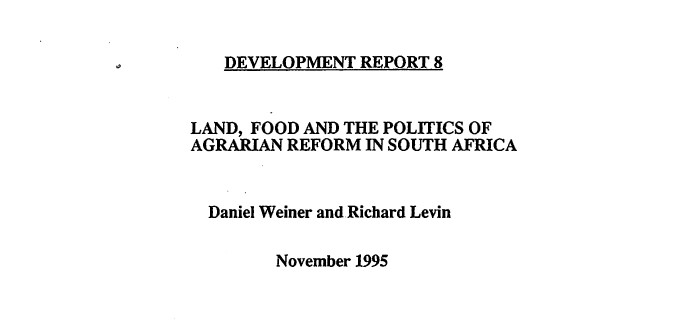Land, Food and the Politics of Agrarian Reform in South Africa
By David Weiner and Richard Levin, November 1995, Development Report No. 8
Executive Summary
In April of 1994, a “new” democratic South Africa was born. The extension of political rights to the whole citizenry of that country was a monumental event that was celebrated globally. The raising of the new South African flag was testimony that a profound change was taking place. One year later, the euphoria is wearing thin as the difficult process of social and economic transformation commences. Despite newly won political freedoms, approximately one-half of South Africa’s 41 million people—and two-thirds of the African population—still live in deep poverty. At least seven million live in shacks. A disproportionate number of South Africa’s poor reside in rural and peri-urban areas.
Despite newly won political freedoms, approximately one-half of South Africa’s 41 million people still live in deep poverty and at least seven million live in shacks.
This report is concerned with post-apartheid land and agrarian reform. Land dispossession was central to the creation of mass poverty and South Africa’s landscape of “separate development.” Colonial and apartheid forced removals and the associated alienation of land and water rights lie at the heart of the repressive regime which the national liberation movement sought to overthrow. To date, land. and agrarian reform policy has tended to be a top-down exercise which is increasingly informed by a neoliberal macro-economic policy orientation. In the report, this elite-pacted transformation process is contrasted with a proposed program of radical structural reform. The role of the World Bank is criticized. The report draws extensively on a participatory research and policy development project recently undertaken in South Africa’s Eastern Transvaal Central Lowveld. Locally produced Village Policy Documents are presented.
It is argued that post-apartheid land and agrarian reform are at the core political processes. The future composition of South Africa’s land and water use patterns—and the agrarian structure at specific places—cannot successfully be decided by technocratic planners and so-called “free” markets within a narrowly defined transition to democracy. A comprehensive restructuring of the apartheid landscape will require a broad-based, popular and participatory rural program that is locally based but nationally and regionally articulated by a committed ANC-led state.


 Help Food First to continue growing an informed, transformative, and flourishing food movement.
Help Food First to continue growing an informed, transformative, and flourishing food movement.




